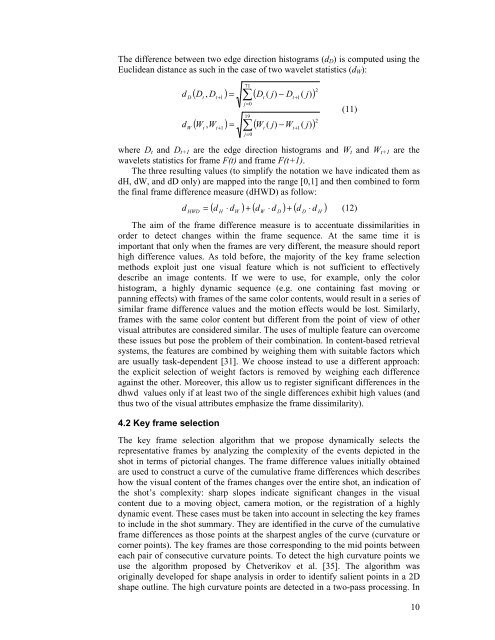an innovative algorithm for key frame extraction in video ...
an innovative algorithm for key frame extraction in video ...
an innovative algorithm for key frame extraction in video ...
Create successful ePaper yourself
Turn your PDF publications into a flip-book with our unique Google optimized e-Paper software.
The difference between two edge direction histograms (d D ) is computed us<strong>in</strong>g theEuclide<strong>an</strong> dist<strong>an</strong>ce as such <strong>in</strong> the case of two wavelet statistics (d W ):ddDW( D , D ) = ( D ( j)− D ( j))tt+1∑( W , W ) = ( W ( j)−W( j))tt+171j=019∑j=0ttt+1t+122(11)where D t <strong>an</strong>d D t+1 are the edge direction histograms <strong>an</strong>d W t <strong>an</strong>d W t+1 are thewavelets statistics <strong>for</strong> <strong>frame</strong> F(t) <strong>an</strong>d <strong>frame</strong> F(t+1).The three result<strong>in</strong>g values (to simplify the notation we have <strong>in</strong>dicated them asdH, dW, <strong>an</strong>d dD only) are mapped <strong>in</strong>to the r<strong>an</strong>ge [0,1] <strong>an</strong>d then comb<strong>in</strong>ed to <strong>for</strong>mthe f<strong>in</strong>al <strong>frame</strong> difference measure (dHWD) as follow:dHWD( d ⋅ d ) + ( d ⋅ d ) + ( d ⋅ d )= (12)HWWThe aim of the <strong>frame</strong> difference measure is to accentuate dissimilarities <strong>in</strong>order to detect ch<strong>an</strong>ges with<strong>in</strong> the <strong>frame</strong> sequence. At the same time it isimport<strong>an</strong>t that only when the <strong>frame</strong>s are very different, the measure should reporthigh difference values. As told be<strong>for</strong>e, the majority of the <strong>key</strong> <strong>frame</strong> selectionmethods exploit just one visual feature which is not sufficient to effectivelydescribe <strong>an</strong> image contents. If we were to use, <strong>for</strong> example, only the colorhistogram, a highly dynamic sequence (e.g. one conta<strong>in</strong><strong>in</strong>g fast mov<strong>in</strong>g orp<strong>an</strong>n<strong>in</strong>g effects) with <strong>frame</strong>s of the same color contents, would result <strong>in</strong> a series ofsimilar <strong>frame</strong> difference values <strong>an</strong>d the motion effects would be lost. Similarly,<strong>frame</strong>s with the same color content but different from the po<strong>in</strong>t of view of othervisual attributes are considered similar. The uses of multiple feature c<strong>an</strong> overcomethese issues but pose the problem of their comb<strong>in</strong>ation. In content-based retrievalsystems, the features are comb<strong>in</strong>ed by weigh<strong>in</strong>g them with suitable factors whichare usually task-dependent [31]. We choose <strong>in</strong>stead to use a different approach:the explicit selection of weight factors is removed by weigh<strong>in</strong>g each differenceaga<strong>in</strong>st the other. Moreover, this allow us to register signific<strong>an</strong>t differences <strong>in</strong> thedhwd values only if at least two of the s<strong>in</strong>gle differences exhibit high values (<strong>an</strong>dthus two of the visual attributes emphasize the <strong>frame</strong> dissimilarity).4.2 Key <strong>frame</strong> selectionThe <strong>key</strong> <strong>frame</strong> selection <strong>algorithm</strong> that we propose dynamically selects therepresentative <strong>frame</strong>s by <strong>an</strong>alyz<strong>in</strong>g the complexity of the events depicted <strong>in</strong> theshot <strong>in</strong> terms of pictorial ch<strong>an</strong>ges. The <strong>frame</strong> difference values <strong>in</strong>itially obta<strong>in</strong>edare used to construct a curve of the cumulative <strong>frame</strong> differences which describeshow the visual content of the <strong>frame</strong>s ch<strong>an</strong>ges over the entire shot, <strong>an</strong> <strong>in</strong>dication ofthe shot’s complexity: sharp slopes <strong>in</strong>dicate signific<strong>an</strong>t ch<strong>an</strong>ges <strong>in</strong> the visualcontent due to a mov<strong>in</strong>g object, camera motion, or the registration of a highlydynamic event. These cases must be taken <strong>in</strong>to account <strong>in</strong> select<strong>in</strong>g the <strong>key</strong> <strong>frame</strong>sto <strong>in</strong>clude <strong>in</strong> the shot summary. They are identified <strong>in</strong> the curve of the cumulative<strong>frame</strong> differences as those po<strong>in</strong>ts at the sharpest <strong>an</strong>gles of the curve (curvature orcorner po<strong>in</strong>ts). The <strong>key</strong> <strong>frame</strong>s are those correspond<strong>in</strong>g to the mid po<strong>in</strong>ts betweeneach pair of consecutive curvature po<strong>in</strong>ts. To detect the high curvature po<strong>in</strong>ts weuse the <strong>algorithm</strong> proposed by Chetverikov et al. [35]. The <strong>algorithm</strong> wasorig<strong>in</strong>ally developed <strong>for</strong> shape <strong>an</strong>alysis <strong>in</strong> order to identify salient po<strong>in</strong>ts <strong>in</strong> a 2Dshape outl<strong>in</strong>e. The high curvature po<strong>in</strong>ts are detected <strong>in</strong> a two-pass process<strong>in</strong>g. InDDH10
















